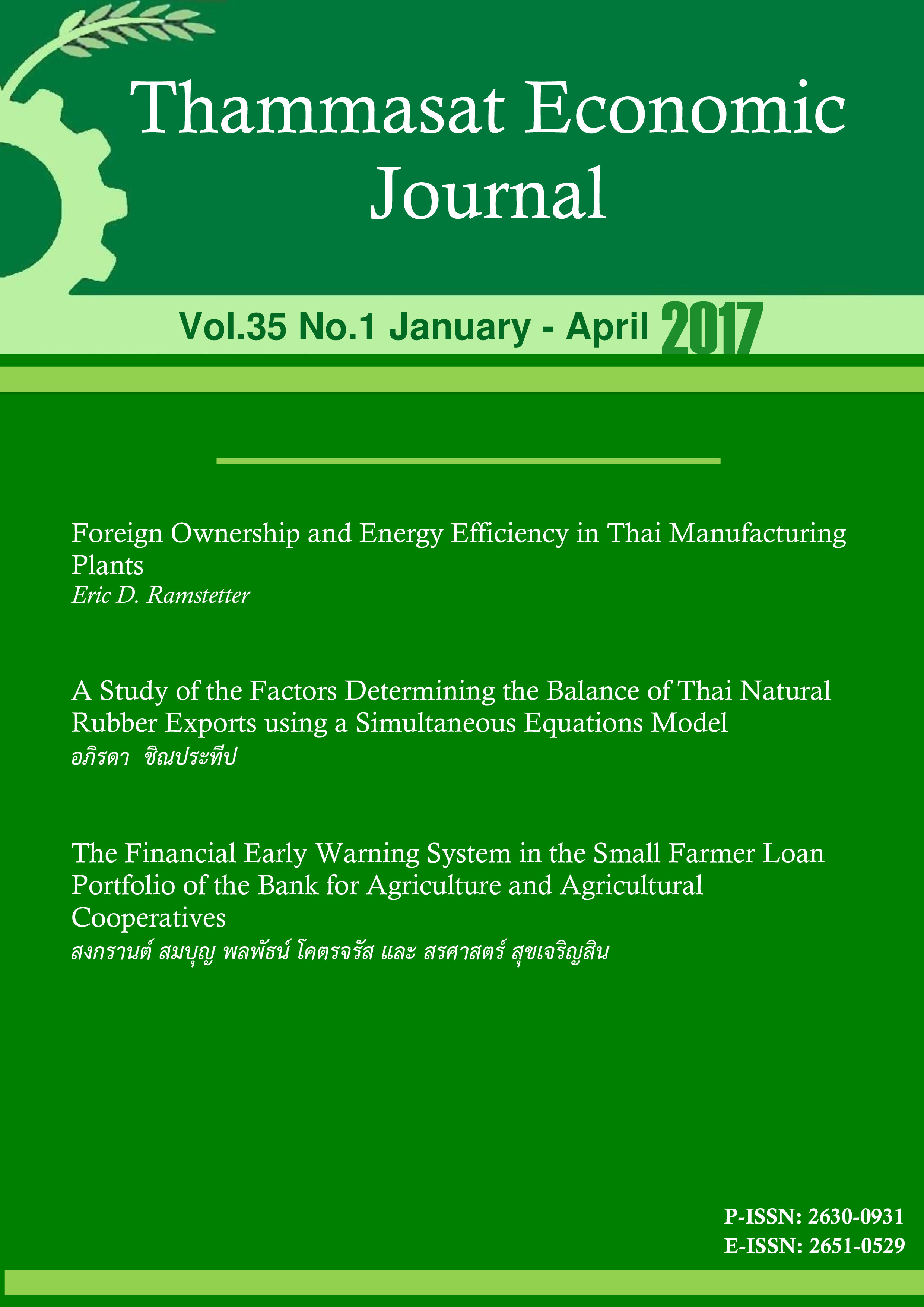A Study of the Factors Determining the Balance of Thai Natural Rubber Exports using a Simultaneous Equations Model
Keywords:
demand, supply, simultaneous equation model, Two-Stage Least SquareAbstract
This study aims to analyze the factors affecting supply and demand in the context of exports of natural rubber from Thailand and the market equilibrium concerning natural rubber in Thailand, based on information regarding secondary market equilibrium in a simultaneous equation model. The relationship of the various constituents and variables within each equation are often related. Therefore, the estimated coefficients are derived using a two-stage least square paradigm. The results of the analysis of factors affecting supply and demand can be explained by changes incurred when external variables alter. The analysis of simultaneous model equations reveals changes in equilibrium quantity or price due to external variable fluctuations. The study found that the factors that explain the price of rubber can be drawn mostly from the demand rather than the supply side. The average income per capita of the country's largest natural rubber importers, the production of vehicles in the world and crude oil can all affect change in the import demand for natural rubber. The aggregate production of vehicles worldwide can also explain changes in the equilibrium price of rubber. Meanwhile, the study uncovered that the important factors explaining variations in the supply of natural rubber for exports are the price of natural rubber, natural rubber plantations and the price of palm oil. However, average rainfall variations do not significantly affect changes in the supply of natural rubber.
References
Alpha C. Chiang (2005). Simultaneous differential equation and difference equation (4th ed., Fundamental methods of mathematical economics). International: McGraw-Hill.
Assanee, N. (2010). The analysis of natural rubber export of Thailand into China. Master’s Thesis, Faculty of Economics, Chulalongkorn University.
Chainatekraisin, T. (2008). Factors that affect and predict the export volume of rubbers from Thailand to Japan. Master’s study, Faculty of Economics, Ramkhamhaeng University. Retrieved from the database network of university libraries.
Chawananon, C. (2014). Factors affecting the natural rubber market equilibrium: Demand and supply response analysis using two-stage least squares approach. San Luis Obispo: Faculty of California Polytechnic State University. Retrieved from http://digitalcommons.calpoly.edu/cgi/viewcontent.cgi?article=2327&con text=theses.
Earth Policy Institute. World Vehicle Production (1950-2003). Retrieved from http://www.earth-policy.org/data_center/.
Federal Reserve Bank of ST. Louis (FRED). World economic indicator and oil price. Retrieved from https://research.stlouisfed.org/fred2/.
Food and Agriculture Organization of the United Nations (FAO). Natural rubber production statistic. Retrieved from http://faostat3.fao.org/compare/E.
Food and Agriculture Organization of the United Nations (FAO). Natural rubber trade statistic. Retrieved from http://faostat3.fao.org/compare/E.
Food and Agriculture Organization of the United Nations (FAO). Palm kernels statistic. Retrieved from http://faostat3.fao.org/compare/E.
Gujarati, D.N. (2009). Simultaneous equation models and time series econometric (5th ed., Basic econometrics). International: McGraw-Hill.
Kaewka, S. (2011). Econometric model of supply and demand for Cassava. Independent Study, Master of Economics, Kasetsart University. Retrieved from the database network of university libraries.
Kannan, M. (2013). The determinants of production and export of natural rubber in India. Journal of Economics and Finance, 1(5), 41-45.
Organization for Economic Co-operation and Development (OECD). World vehicle production (2004-2013). Retrieved from https://data.oecd.org/searchresults/?q= vehicles+production.
Palawan, S. (2005). Factors that determine supply and demand of Thailand’s rubber exports. independent study, Master of Economics, Kasetsart Universit. Retrieved from the database network of university libraries.
Purcell, D. (1993). The factor affecting the long run supply of rubber from Sarawak East Malaysia. Master of Agricultural Economic, Queensland University.
Ratchanakul, N. (2011). Factors affecting the market equilibrium of Thailand’s rice exports to Saudi Arabia. Master’s Economic thesis, Kasetsart University. Retrieved from the database network of university libraries.
Srisombat, W. (1999). Analysis of the ability to export rubbers. Thesis, Master of Economics, Ramkhamhaeng University. Retrieved from the database network of university libraries.
Weanmana, S., Puangchompoo, S., & Kakulpim, P. (2014). Factors affecting the quantity, output of rubber in the northeastern. Thesis in Economics, Department of Agricultural Economics, Khonkaen University. Retrieved from the database network of university libraries.










